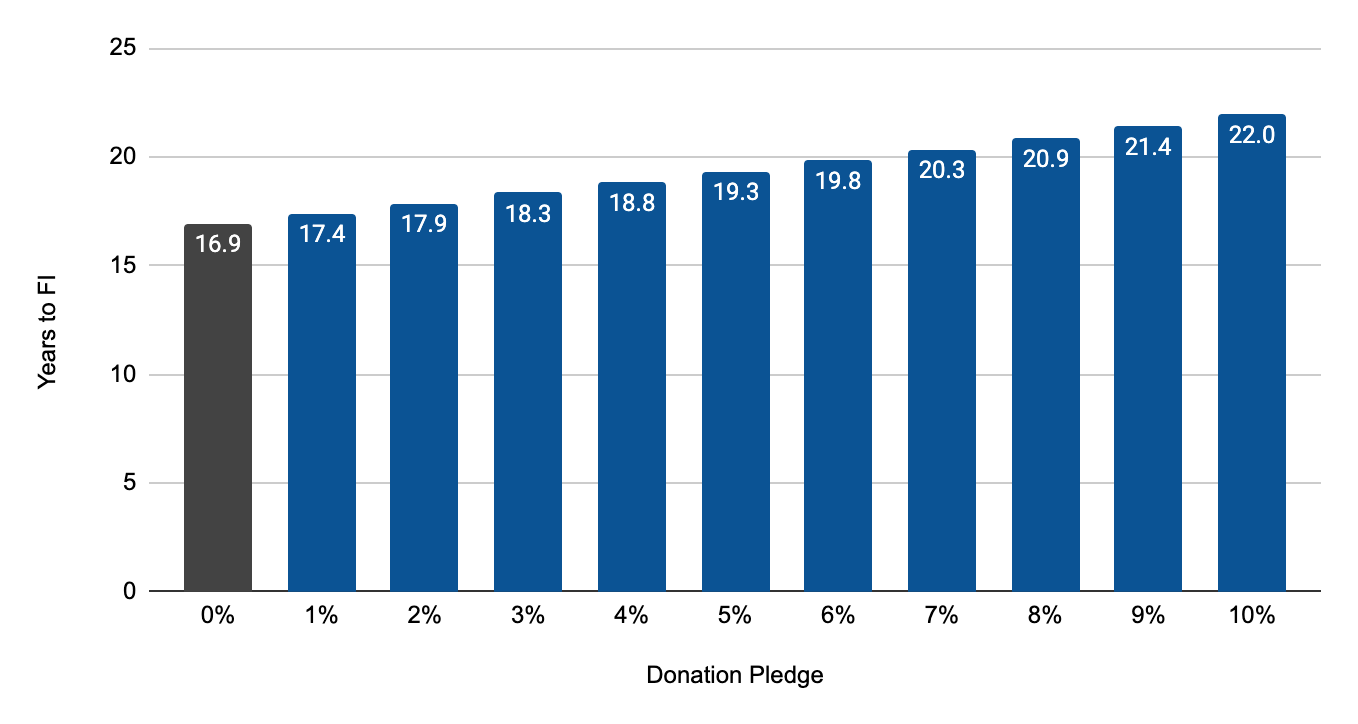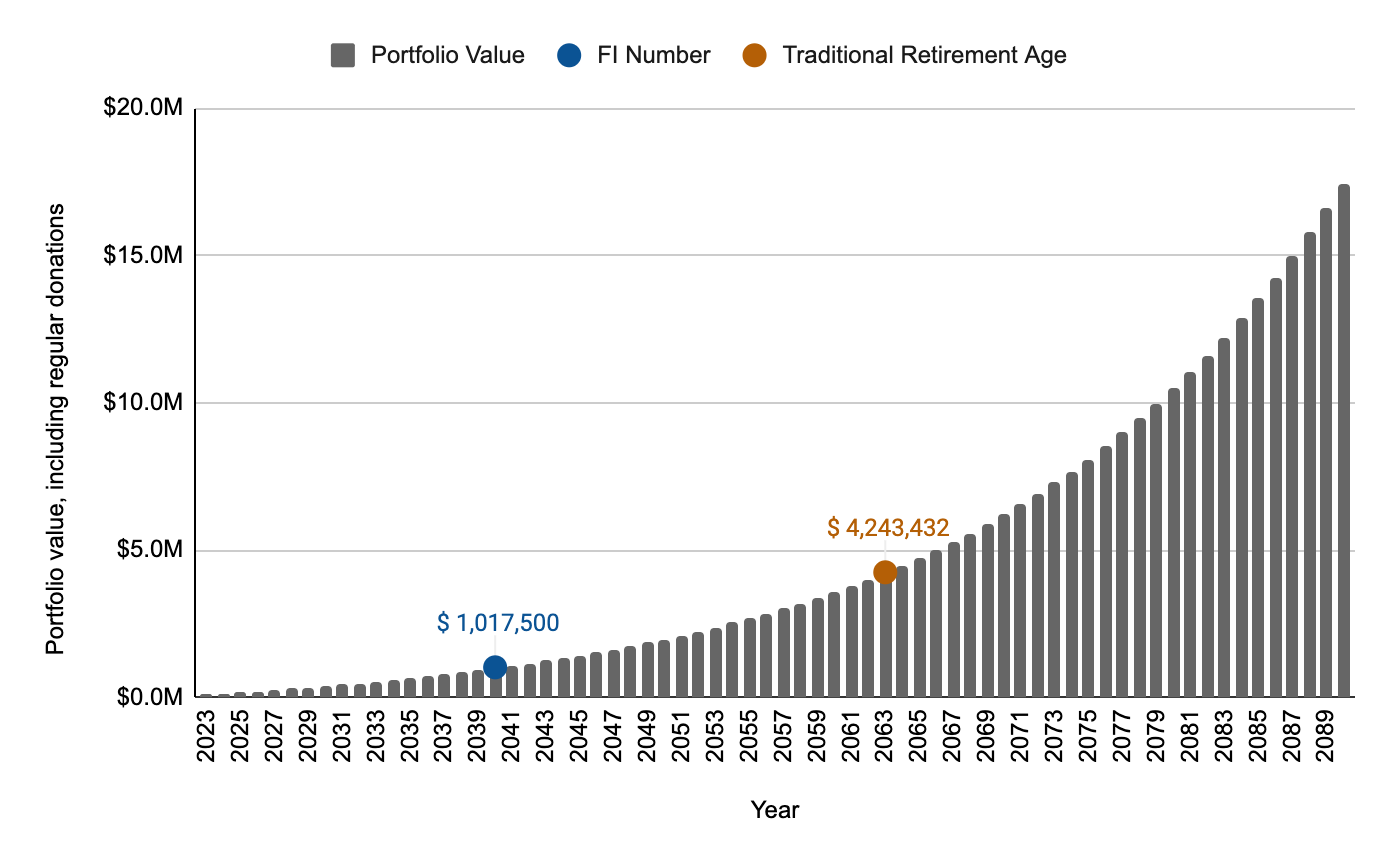UPDATE 2 FEBRUARY 2023: I've updated a new and streamlined version of the “FI-lanthropy Calculator” based on the comments of many.
REQUEST
I am soliciting feedback on a tool I have made entitled the "FI-lanthropy Calculator". The target audience includes existing or aspiring members of the FIRE movement (Financial Independence Retire Early). They may use this calculator to explore the impact of taking a giving pledge both to their FI timeline and their retirement portfolio.
This tool is meant to be simple to use and easy to digest. It is not a comprehensive financial plan, but more so a way to ‘whet the appetite’ for giving in general. I view this tool as a companion to, say, The Life You Can Save’s Impact Calculator. We know this is not exact, but it’s a good place to see tangible examples of how much good you can do.
I’d like to know:
- If you find this tool helpful and/or informative
- If you think it is missing anything crucial (keeping in mind I want to keep it relatively simple)
- If there are any major errors I’ve missed
RATIONALE
There is a growing movement within the FIRE community of people who are focused on giving back and looking for ways in which they can successfully find financial independence but also create space to help others. This can be seen through the growing number of members in the Socially Conscious FIRE facebook group (now at ~9,000 members, up from <1,000 when I joined in May 2020). We also see true leaders within the Financial Independence community continuing to lean into this space include: Pete Adeney of Mr. Money Mustache advocates for Effective Altruism directly on his blog, Tanja Hester of Our Next Life has written Wallet Activism, and Vicki Robin has her podcast What Could Possibly Go Right. (The last two are not EA focused, but have had a very large influence on getting people to think more about charitable giving in general.)
I believe there is a large audience here for the EA community to reach (Mr. Money Mustache’s blog has had tens of millions of visitors), with advocates already in place. My hope is to provide more tools and resources for the FI community to consider some of the EA practices, largely Earn to Give and Invest to Give.
While some may feel that the communities clash (FIRE focuses on bettering oneself while EA focuses on bettering others), I believe that there are more synergies than we might think:
- FIRE folks are optimizers: They ensure that each dollar is working for them, and that little money is wasted. They believe that each dollar they spend or save goes to a useful cause. It is likely FIRE followers will more readily understand the importance of effective charitable donations, knowing their dollar does the most good possible.
- FIRE folks spend time to understand what makes them happy: FIRE followers, if diligent, have spent a significant amount of time evaluating the marginal benefit of spending more money on themselves once their basic needs are met. And thus, if they have money to satisfy their basic needs and more, there is an opportunity to share this money with others.
- FIRE folks who are close to retiring early or have already retired are looking for meaning: While it’s true that many people are focused on the journey to getting to early retirement, at some point the question will come up “What is the point of all this?”. And many find that it’s less about quitting their full time work and more about finding meaning in life. And quitting your job gives you a lot more space to think through that. Vicki Robin uses the Hero’s Journey to explain this concept exceptionally well in this video.
- Many seek FI without the need to RE: Many folks don’t necessarily want to retire early, they just want the ability to become Financially Independent. Being FI allows you to make life changes more easily as you are not obliged to stick with a certain job that provides a specific income level. Many who reach partial FI, or Coast FI, start to make big life changes, having achieved a baseline of financial security. And often that means leaning into more purposeful work that perhaps pays less. For example, someone who leaves a high paying job in tech to start an effective charity.
QUICK SUMMARY OF INSIGHTS
Let's walk through an example: Let's say you make $70,000 a year after taxes, and spend $40,000 a year, meaning you have a personal savings rate of 43%. You already have $100,000 in your investment portfolio. You have not yet taken a Giving Pledge but are considering donating 1% on a go-forward basis.
Using the Fi-lanthropy Calculator, you would find that pledging 1% would increase your FI timeline by 0.5 years, or 6 months of working. In the scheme of 17+ years of working, this may be noticeable but not substantial.

Assuming your income and expenses remained the same, it means you would donate $700 a year, or $21,000 over the course of 30 years. According to The Life You Can Save's Impact calculator, this means you could help to purchase 10,500 bednets to protect those living in malaria-stricken areas from infected mosquitos, and help save 5 lives.
You would still be reach early retirement in 17+ years, with an estimated portfolio value of $1,017,500, or you may choose to keep working to earn active income. Either way, you have a nest egg to donate upon your death in addition to regular donations.
Donating even just the baseline target FI number, again $1,017,500, would help purchase 508,750 bednets, or 254 lives saved based on today's estimates.

There are of course a number of assumptions here, and you may read more about those directly in the calculator.
TECHNICAL COMMENTARY
I made this in Google Sheets because my technical capabilities only extend this far. I am aware that making this an online tool with a slightly sexier design would improve the user experience.
With that said, if there are any data scientists, engineers, or developers who are reading this who would be looking to partner on this, please reach out.
For those of you familiar with Networthify’s Early Retirement Calculator (an extremely popular FIRE calculator featured in the community often), the Fi-lanthropy Calculator uses similar assumptions.
PERSONAL BACKGROUND
I am a member of both the FIRE and EA communities. I retired from my corporate real estate job 3 years ago at the age of 32. Now I live an early retiree lifestyle and also run my nonprofit Yield & Spread. We teach working adults how to learn and invest to build wealth, and we distribute all our profits after operating costs to effective charities. We are working towards creating more content around financial independence and giving, starting with this Fi-lanthropy calculator.
I am a personal believer that financial literacy is another superpower we can unlock to do more good in this world. The better we can take care of ourselves, the more we can create space for others. I continue to see requests for Personal Finance support (as you can see from this EA Forum post), and I hope to help in this space as much as I can.
This is my first time writing an EA forum post.
SUMMARY
I believe having more tangible tools that people can use to calculate their donation impact is helpful, especially in the context of personal finance. I welcome your feedback on this Fi-lanthropy calculator, and any other thoughts on desired content.





As for the direct, object-level questions you make: Yes, it's very helpful and informative, and I don't see any major errors. In fact, the "additional funds required" and "extra time to FIRE" charts are very useful, and to my knowledge, haven't been done before. Congrats!
As for something missing, something I sometimes get requested to calculate is how great is the impact of donating now vs. donating later. Like, what if I want to extra-quickly grow my nest egg for 6-10 years or until 60-80% of the way into FI (amounts to be written-in, of course), before donating? Would that lower my donations much? That is, the reverse of "how much delay for this amount of donations?".
As general commentary / small things / nitpicks:
Extremely helpful commentary. I've updated the charts with your recommended formula per comment No. 4, and given some extra commentary around No. 2 and 3. I'll have to give some more thought to your comments about "donating now vs. donating later" and incorporating this level of flexibility. There's probably a few ways of doing this -- and perhaps this is best done in a separate section or separate calculator even. It also encourages me think a bit more about audience for this tool -- if you are new to giving then my gut tells me somethin... (read more)